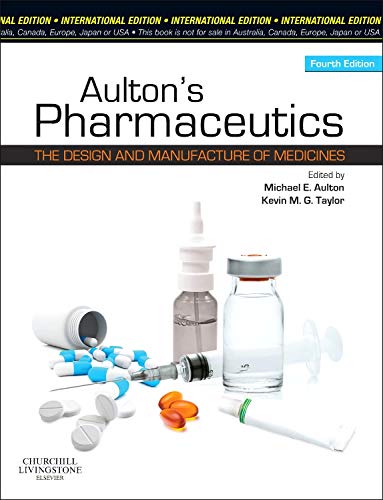1. Aulton's Pharmaceutics
Pharmaceutics is one of the most diversified fields of study in pharmaceutical science. In a nutshell, it deals with the scientific and technical elements of designing and manufacturing dosage forms or medications. Understanding pharmaceutics is thus essential for all pharmacists and pharmaceutical scientists engaged in the conversion of a medication or prospective drug into a treatment that can be provided safely, efficiently, and conveniently to the patient. This best-selling pharmaceutics textbook, now in its fourth edition, has been completely updated to reflect rapid advances in delivery methodologies by eye and injection, advances in drug formulations and delivery methods for special groups (such as children and the elderly), nanomedicine, and pharmacognosy. At the same time, the editors have worked hard to keep the book accessible to pharmacy students, striking a balance between being a well pitched introduction text and a clear depiction of the state of the art.
2. Pharmacology (Lippincotts Illustrated Reviews Pharmacology)
Lippincott® Illustrated Reviews: Pharmacology, Seventh Edition, is students® favorite review resource for studying the fundamentals of medical pharmacology. It presents up-to-date drug information in an accessible format ideal for a quick, effective refresher.
This concise resource, part of the popular Lippincott® Illustrated Reviews series, features clear, effective writing and hundreds of illustrations that break down complex information for quick review. Sequential images present mechanisms of action and focus on showing students how drugs work rather than telling them and review questions with answers provide powerful, practical exam preparation.
The most recent, therapeutically relevant pharmacology content is included in updated medication information.
An approachable outline format simplifies the review of complex information.
In vivid detail, high-quality illustrations reinforce understanding.
Enhanced review questions with answers assess students' comprehension and identify areas for further investigation.
3. Applied Biopharmaceutics and Pharmacokinetics
The textbook Applied Biopharmaceutics and Pharmacokinetics cover both theoretical and practical applications of biopharmaceutics and pharmacokinetics. This book goes into depth regarding drug product performance and biopharmaceutics, as well as how biopharmaceutics influences drug product performance.
performance and define pharmacokinetics, as well as explain how pharmacokinetics relates to pharmacodynamics and medication toxicity
4. An Introduction to Medicinal Chemistry
The major textbook for university courses on medicinal chemistry is An Introduction to Medicinal Chemistry.
This book is valued equally by students and professors due to its more educational content; it delivers the entire covering in an approachable and entertaining way.
The book starts with the fundamental biochemistry that serves as the foundation for understanding medicinal chemistry, explaining the structure and function of significant drug targets. The book then delves into how drugs interact with the body and the implications of those interactions. There includes a part on broad ideas and tactics for finding and creating novel medications, as well as a section on important 'tools of the trade.' The book concludes with a look at current themes in medicinal chemistry, such as antiviral and anticancer compounds, cholinergic and anticholinesterases, and antiulcer agents.
Throughout, there are learning opportunities. An Introduction to Medicinal Chemistry might help you learn more about this intriguing topic. A glossary may assist you to learn the jargon of medicinal chemistry. Boxes give in-depth information and investigate how topics are utilized in practise. Key points summarise parts within chapters and serve as a foundation for revision, while questions after chapters and on the associated Online Resource Centre enable the reader to test their comprehension and enhance molecular modeling abilities.
5. Remington: Essentials of Pharmaceutics
Remington: Essentials of Pharmaceutics is a brief but comprehensive book that covers all elements of pharmaceutics, from scientific basics to dosage forms and drug delivery methods to drug product evaluations, and aids in the integration of pharmacy theory into practice.
Parenteral, sterilizing methods, and sterile compounding are discussed, as well as different distribution modes and dosage forms. In addition, some basic principles on drug research and drug product approval are offered, as well as information resources in pharmacy and the pharmaceutical sciences.
This resource provides a concise yet detailed overview of all aspects of pharmaceutics, from scientific fundamentals to dosage forms and drug delivery systems to drug product analyses. Assists in the integration of pharmacy science into practice. This new edition was created by specifically selecting chapters from the original parent text Remington: The Science and Practice of Pharmacy 22nd edition. The Pharmaceutics and Pharmaceutical Dosage Forms sections are heavily referenced in the text. Parenterals, sterilization processes, and sterile compounding are all covered, as well as various delivery systems and dosage forms. One chapter is about pharmaceutical excipients, while another is about pharmaceutical packaging. Also covered are pharmaceutical analysis, product characterization, quality control, stability, bioavailability, and dissolution.
Thermodynamics, ionic solutions and electrolyte equilibria, tonicity, chemical kinetics, rheology, complex formation, and interfacial phenomena are among the fundamental scientific concepts covered. The text also covers pharmacokinetics and pharmacodynamics, as well as the principles of absorption, distribution, metabolism, and excretion. In addition, some basic principles on drug research and drug product approval are offered, as well as information resources in pharmacy and the pharmaceutical sciences.





